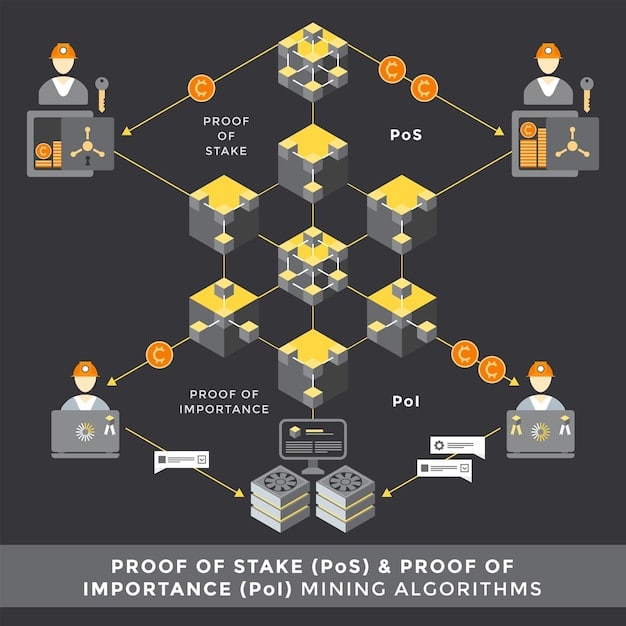Altcoin Cross-Chain Interoperability: Projects for Seamless Transfers

Altcoin cross-chain interoperability refers to the ability of different altcoins—cryptocurrencies other than Bitcoin—to communicate, share data, and transact with each other across various blockchain networks, enabling seamless transfers and broader usability.
In the ever-evolving landscape of cryptocurrencies, altcoin cross-chain interoperability: exploring projects that connect different blockchains for seamless transfers stands as a crucial development, addressing the fragmentation and isolation that have long characterized the digital asset space.
Understanding Altcoin Cross-Chain Interoperability
Altcoin cross-chain interoperability is a multifaceted topic with significant implications for the future of blockchain technology. It’s about creating a cryptocurrency ecosystem where different digital currencies can work together seamlessly.
This section explores the underlying concepts of cross-chain interoperability, its benefits, and the challenges involved.
What is Cross-Chain Interoperability?
Cross-chain interoperability refers to the ability of different blockchain networks to connect, communicate, and share data with one another. In essence, it allows for the transfer of assets and information between otherwise isolated blockchains, enabling new possibilities for decentralized applications and services.
Benefits of Interoperability
The advantages of cross-chain interoperability are numerous. They range from enhanced liquidity to broader usability of digital assets.
- Increased Liquidity: By allowing assets to move freely between chains, interoperability can consolidate fragmented liquidity pools, making it easier to buy, sell, and trade altcoins.
- Enhanced Scalability: Interoperability can help alleviate congestion on popular blockchains by enabling users to move assets to less crowded chains for faster and cheaper transactions.
- Greater Innovation: By providing developers with access to a wider range of tools and resources, interoperability can foster innovation and the development of new decentralized applications.
- Improved User Experience: Interoperability can simplify the user experience by allowing users to manage their digital assets across multiple chains from a single interface.

In conclusion, understanding the fundamentals of cross-chain interoperability is crucial to grasping its potential impact on the cryptocurrency ecosystem, paving the way for a more interconnected and efficient future.
Key Projects Enabling Cross-Chain Transfers
Several projects are at the forefront of enabling cross-chain transfers, each with its unique approach and technology. These projects are critical in realizing the vision of a truly interconnected blockchain ecosystem.
This section highlights some of the most promising projects in the space.
Polkadot
Polkadot is a multi-chain network that allows different blockchains, known as parachains, to connect and communicate with one another. It uses a central relay chain to facilitate cross-chain transactions and data transfers.
Polkadot’s architecture is designed to be highly scalable and flexible, allowing developers to easily create and deploy customized parachains that can interoperate with other chains in the network.
Cosmos
Similar to Polkadot, Cosmos is another project aiming to create an “internet of blockchains.” It uses a modular framework called the Inter-Blockchain Communication (IBC) protocol to enable cross-chain communication and value transfer.
Cosmos emphasizes sovereignty, allowing each blockchain to maintain its own governance and consensus mechanisms while still being able to interoperate with other chains in the ecosystem.
Chainlink
Chainlink is a decentralized oracle network that provides secure and reliable data feeds to smart contracts. While not strictly a cross-chain transfer protocol, Chainlink plays a crucial role in enabling cross-chain applications by providing the necessary data for smart contracts to interact with different blockchains.
- LayerZero: A cross-chain messaging protocol designed for low-cost and secure transfers.
- Wormhole: A generic message-passing protocol that connects to multiple chains.
- Ren Protocol: Focuses on bringing inter-blockchain liquidity for decentralized applications.
In conclusion, these projects collectively contribute to the evolution of cross-chain technology, each offering unique solutions that are shaping the future of decentralized finance and blockchain interoperability.
Technical Approaches to Achieving Interoperability
Achieving interoperability involves various technical approaches, each with its own trade-offs in terms of security, scalability, and complexity. Understanding these approaches is essential for evaluating the potential of different cross-chain solutions.
This section breaks down some of the most common technical strategies.
Bridging
Bridging is a common approach that involves creating a connection, or “bridge,” between two blockchains. This allows users to transfer assets from one chain to another by locking them up on the original chain and minting corresponding tokens on the destination chain.
Atomic Swaps
Atomic swaps are a peer-to-peer method for exchanging one cryptocurrency for another without the need for a trusted intermediary. They use a technology called Hash Time-Locked Contracts (HTLCs) to ensure that the exchange is either fully executed or completely cancelled, protecting both parties from fraud.
Relays
Relays are a more complex approach that involves creating a lightweight client of one blockchain on another blockchain. This allows the second blockchain to verify the state of the first blockchain and execute cross-chain transactions based on that information.

In summary, each technical approach to interoperability presents its own set of advantages and challenges, influencing the overall effectiveness and security of cross-chain interactions within the blockchain space.
Security Considerations in Cross-Chain Solutions
Security is paramount in cross-chain solutions, as vulnerabilities in one chain can potentially compromise the entire ecosystem. It’s crucial to understand the security risks involved and the measures being taken to mitigate them.
This section discusses the key security aspects of cross-chain interoperability.
Smart Contract Vulnerabilities
Many cross-chain solutions rely on smart contracts to manage the locking and minting of assets. If these smart contracts contain vulnerabilities, they can be exploited by attackers to steal funds or manipulate the system.
Consensus Mechanism Attacks
Cross-chain solutions that rely on relays or light clients are vulnerable to attacks on the consensus mechanisms of the underlying blockchains. If an attacker can compromise the consensus of one chain, they may be able to manipulate the relay and execute fraudulent cross-chain transactions.
Bridge Exploits
Bridges, while popular, have been frequent targets of exploits. These typically involve vulnerabilities in the bridge’s smart contracts or the underlying infrastructure, leading to significant financial losses.
- Audits and Formal Verification: Rigorous code audits and formal verification can help identify and eliminate vulnerabilities in smart contracts.
- Decentralized Governance: Decentralized governance mechanisms can help ensure that cross-chain systems are resistant to manipulation and censorship.
- Insurance and Risk Mitigation: Insurance protocols and other risk mitigation strategies can help protect users from losses due to security breaches.
In conclusion, security is a critical concern for cross-chain solutions, and a multi-layered approach involving robust code audits, decentralized governance, and risk mitigation strategies is essential to secure these interconnected systems.
The Future of Altcoin Interoperability
The future of altcoin interoperability looks promising, with ongoing advancements in technology and increasing adoption by developers and users. Interoperability is poised to play a central role in the evolution of the cryptocurrency ecosystem.
This section explores the potential future developments and trends in cross-chain interoperability.
Increased Adoption
As cross-chain solutions become more mature and user-friendly, we can expect to see increased adoption by developers and users. This will lead to a more interconnected and efficient cryptocurrency ecosystem.
New Use Cases
Interoperability will unlock new use cases for cryptocurrencies, such as cross-chain decentralized exchanges, lending platforms, and gaming applications. These new use cases will further drive adoption and innovation in the space.
Standardization Efforts
Standardization efforts, such as the development of common protocols and APIs, will help facilitate interoperability between different cross-chain solutions. This will make it easier for developers to build applications that can interact with multiple chains seamlessly.
In summary, the future of altcoin interoperability is bright, with increasing adoption, new use cases, and standardization efforts paving the way for a more interconnected and efficient cryptocurrency ecosystem.
Challenges and Limitations of Current Solutions
While cross-chain interoperability holds great promise, it’s important to acknowledge the challenges and limitations of current solutions. Overcoming these challenges is essential for realizing the full potential of interoperability.
This section discusses some of the key obstacles facing cross-chain interoperability.
Scalability Issues
Many cross-chain solutions are still limited in terms of scalability. As the number of transactions and users increases, these solutions may struggle to keep up, leading to congestion and higher fees.
Complexity
Cross-chain solutions can be complex to implement and use, requiring specialized knowledge and skills. This can make it difficult for developers and users to adopt these technologies.
Regulatory Uncertainty
The regulatory landscape for cryptocurrencies is still evolving, and there is considerable uncertainty about how cross-chain solutions will be treated by regulators. This can create challenges for projects seeking to operate in this space.
| Key Aspect | Brief Description |
|---|---|
| 🔗 Interoperability | Enables communication and data sharing between different blockchains. |
| 🛡️ Security Risks | Includes smart contract vulnerabilities and consensus mechanism attacks. |
| 🚀 Future Trends | Increasing adoption, new use cases, and standardization efforts. |
| ⚖️ Regulatory Issues | Uncertainty around how cross-chain solutions will be treated by regulators. |
FAQ
Cross-chain interoperability allows different blockchain networks to communicate and share data with each other. This enables the transfer of assets and information between otherwise isolated blockchains.
Benefits include increased liquidity, enhanced scalability, greater innovation, and improved user experience. It helps in consolidating fragmented liquidity pools and facilitates easier transactions.
Key projects include Polkadot, Cosmos, and Chainlink. Each of these projects offers unique approaches and technologies to facilitate cross-chain communication and value transfer.
Security considerations include smart contract vulnerabilities, consensus mechanism attacks, and bridge exploits. It’s crucial to implement robust security measures and risk mitigation strategies.
The future looks promising with increased adoption, new use cases, and standardization efforts. Interoperability is expected to play a central role in the evolution of the cryptocurrency ecosystem.
Conclusion
In conclusion, altcoin cross-chain interoperability presents a transformative approach to integrating diverse blockchain networks, promising enhanced liquidity, scalability, and innovation, although significant challenges related to security and regulatory compliance must be thoughtfully addressed to ensure its successful and widespread adoption.





